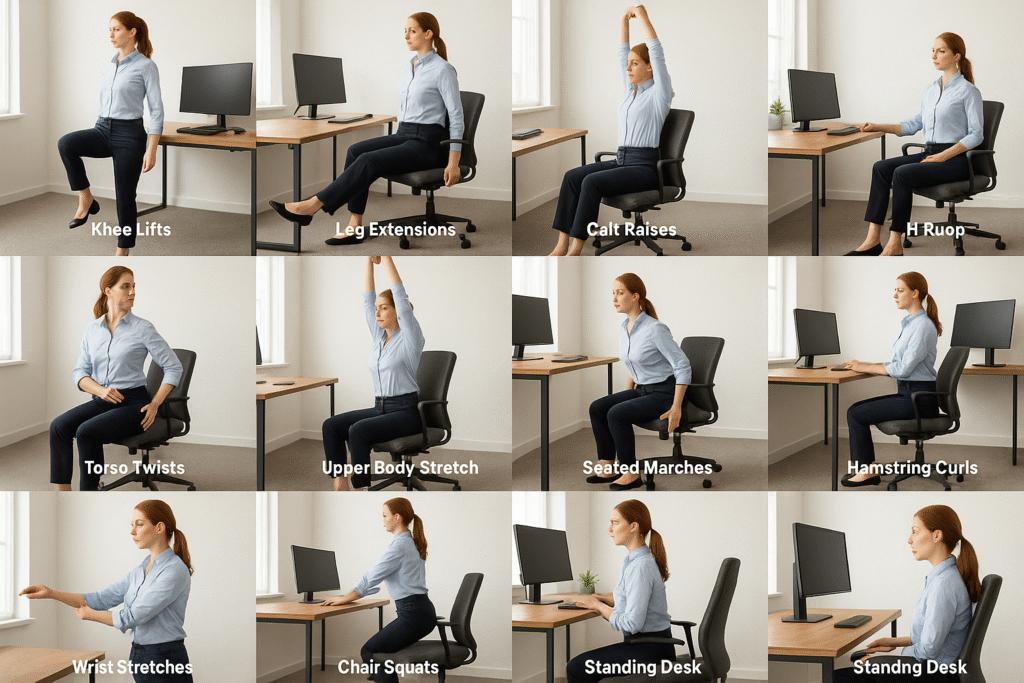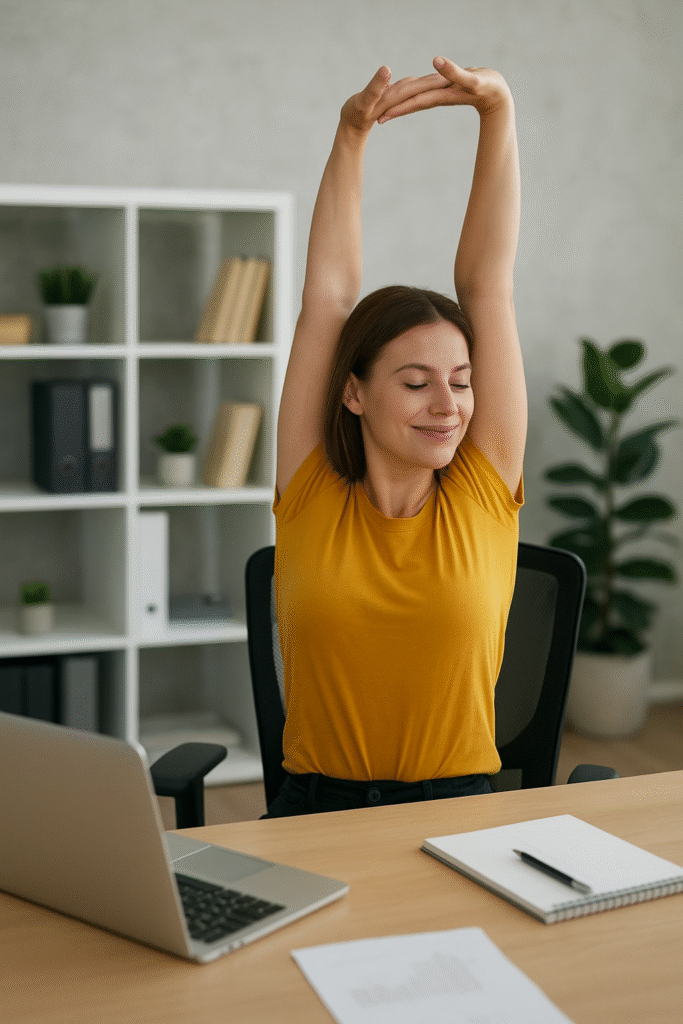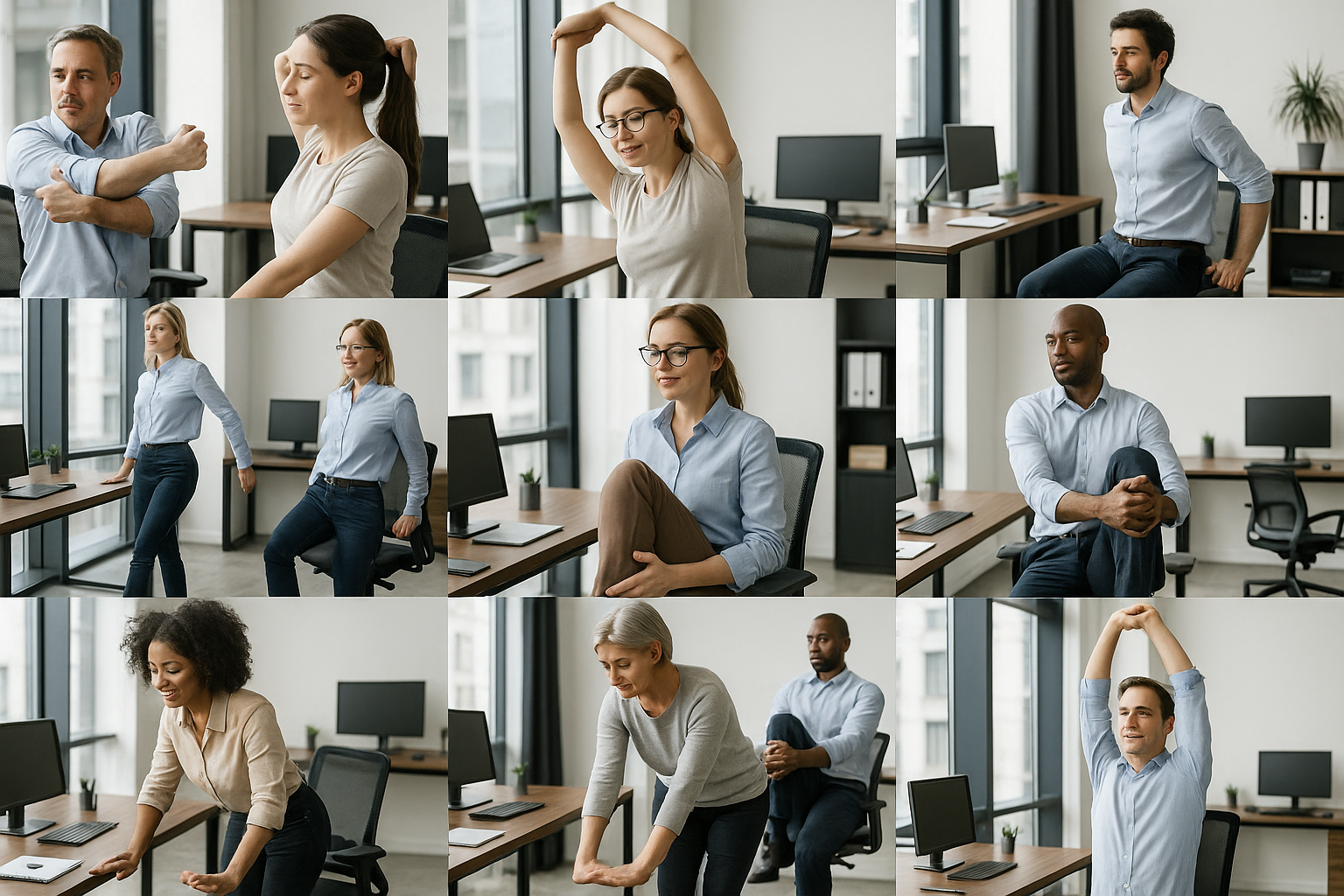Sitting all day is quietly reshaping our health. From higher heart-disease and diabetes risk to back pain and poorer concentration, the harms of a sedentary workday are real — but fixable. This long-form, evidence-backed guide from TrenBuzz brings you the latest global, US and UK data, explains the physiology behind the sitting risks, and gives you easy, realistic desk exercise routines plus workspace swaps you can use today. There’s an interactive 30-day plan, quick mini-routines, and links to government-authorised resources at the end so you can act with confidence.
Why this matters now (short, sharp data you can’t ignore)
- Nearly 1.8 billion adults worldwide — about 31% of the adult population — did not meet recommended physical activity levels in 2022, increasing population risk for chronic disease. (World Health Organization)
- In the United States, national surveys show roughly 24–25% of adults report no leisure-time physical activity, and employer guides now emphasise short activity breaks to protect worker health. (CDC)
- In the UK, many adults sit around 9 hours/day when work, transport and screen time are combined — and public health guidance explicitly recommends breaking up long sitting periods with light activity. (nhs.uk, GOV.UK)
Put bluntly: sedentary time is common and rising. The science links prolonged sitting to higher risks of cardiovascular disease, type 2 diabetes, some cancers, musculoskeletal problems and even cognitive decline — all amplified if sitting is continuous and unbroken. (PMC, The Lancet)
What sits behind the danger: brief physiology (so the hacks make sense)
When you sit for long periods:
- Your muscle contractions that help burn glucose and circulate blood are reduced → poorer blood sugar control and higher insulin resistance risk.
- Venous return from the legs slows → greater risk of clotting and poorer circulation.
- Posture often becomes poor → sustained spinal loading, neck strain and weakened glutes/core.
- Long uninterrupted sitting also correlates with higher resting heart rate and lower cardiorespiratory fitness.
The good news: short, frequent interruptions (standing, marching on the spot, a 2–10 minute walk) reverse many of these acute effects and compound into meaningful long-term benefits if done consistently. (PMC, NASA)
Big picture approach: “Move, Micro-break, Modify” (the simple framework)
- Move — add intentional movement episodes across the day (10–15 minute walks; brisk stairs).
- Micro-break — every 30–60 minutes, stand and do a 1–3 minute desk exercise to interrupt sitting.
- Modify — change your workspace to reduce continuous sitting (sit–stand desk, active seating, walking meetings).
Everything below is built from that three-step framework.

11 desk exercise routines you can do at your workstation (no equipment, 1–6 minutes each)
Each mini-routine is designed to be discreet, safe, and effective. Aim to do one micro-break every 30–60 minutes and a longer 10–15 minute routine twice a day.
1) Ankle pumps (1 minute)
Sit tall, point toes down, then flex to the sky — 30–60 seconds. Improves calf pump and circulation.
2) Seated march (60–90 seconds)
Lift knees alternately while seated at a brisk cadence — hands on desk for support. Easy cardio boost.
3) Chair sit-to-stand (10–15 reps)
Stand up from the chair and sit back down slowly. Strengthens glutes and quads.
4) Desk hip hinge (6–10 reps)
Standing, hands on desk, hinge at hips with soft knees, keeping back flat—feel stretch in hamstrings and low back.
5) Seated spinal twist & thoracic opener (30 seconds each side)
Rotate torso gently to each side holding the back of your chair — helps mobility and posture.
6) Shoulder blade squeezes (20 reps)
Sit or stand, squeeze shoulder blades together for 2–3 seconds; releases neck/shoulder tension.
7) Standing calf raises (20–30 reps)
Rise onto toes and slowly lower—great for circulation and balance.
8) Wall/desk push-ups (10–15 reps)
Inclined push-ups using your desk or a wall to build upper body strength with minimal space.
9) Neck mobility (30–60 seconds)
Slowly nod and turn the head, then tilt each ear to shoulder—relieves tech-neck.
10) Glute clench (isometric) (30 seconds on/off × 3)
Squeeze glutes while seated or standing to engage posterior chain.
11) Eye & focus break (20-20-20 rule)
Every 20 minutes look at something 20 feet away for 20 seconds—reduces eye strain and cognitive fatigue.
Quick tip: set a silent phone timer or an app to cue micro-breaks (many workers benefit from the simple cadence of 30–60 minute prompts). Public health & workplace guides suggest frequent short breaks are feasible and effective. (CDC)
6 Desk-to-Desk swaps and low-cost workspace upgrades that actually work
These are prioritized by impact and ease of adoption.
1) Sit-stand desk or desktop riser
Switching between sitting and standing reduces total sitting time and improves comfort. Start with 10–20 minute standing blocks and build up. Evidence supports health and productivity benefits when used sensibly.
2) Active seating options
Balance stools, wobble cushions or stability balls increase micro-movement while seated and engage core muscles.
3) Small under-desk pedal or stepper
For gentle cardio while on the phone or during long calls. Keeps blood flowing without distracting colleagues.
4) Create walking meeting culture
Replace short internal sit-downs with 10–20 minute walks (calls or in-person). Walking meetings boost creativity and step counts.
5) Reposition printer/water cooler/phone
Make common tasks just far enough that they trigger a short walk every hour—small behaviour changes add up.
6) Staggered routine + calendar scheduling
Block “movement meetings” on your calendar — synchronise team micro-breaks or set a shared reminder for group stretch sessions.

10-Minute desk exercise routines (two options)
Choose one mid-morning and one mid-afternoon to break up long sitting blocks.
Routine A — Cardio & Mobility (10 min)
- 1 min seated march
- 1 min standing calf raises
- 1 min chair sit-to-stand (slow)
- 2 min brisk walk (around the office/home)
- 2 min shoulder & thoracic mobility (desk push-ups + shoulder squeezes)
- 2 min core activation (standing plank on desk or glute clench circuits)
- 1 min cooldown & breathing
Routine B — Strength & Posture (10 min)
- 2 min warmup (march in place)
- 2×10 desk push-ups
- 2×12 single-leg sit-to-stand (assisted if needed)
- 1 min wall squats (hold 30s × 2)
- 2 min thoracic rotation + neck mobility
- 1 min breathing reset
30-day “Sitting Risks” challenge (interactive plan you can embed/print)
Week 1 — Awareness & Micro-break habit
- Goal: stand or micro-move every 45 minutes; total 10 extra standing minutes/day.
Week 2 — Add two 10-minute routines per day
- Goal: complete Routine A or B morning & afternoon.
Week 3 — Workspace swaps
- Goal: incorporate 1 sit-stand block daily; schedule 2 walking meetings.
Week 4 — Consolidate & track
- Goal: reduce continuous sitting bouts to <60 minutes and maintain daily steps + micro-breaks.
Track daily with a simple table (printable):
| Day | Micro-breaks (count) | Standing minutes | 10-min routines done? Y/N | Notes |
|---|
Special considerations: people with mobility limits or chronic conditions
Not everyone can stand or do active workouts. Alternative micro-breaks (seated mobility, breathing, gentle stretches) still reduce sedentary time and help circulation. Always consult a clinician before changing physical-activity patterns if you have cardiovascular conditions, recent surgery, or major mobility issues. NHS and CDC guidance include sections for adapted activity. (nhs.uk, Health.gov)
The employer angle — why workplaces should care (brief ROI)
Employers who encourage activity see benefits in reduced musculoskeletal complaints, lower presenteeism and improved morale. CDC and public-health workplace guides provide free toolkits on implementing short activity breaks and creating movement-friendly policies. Integrating micro-breaks is low cost and aligns with occupational health recommendations. (CDC)
Quick FAQ (reader friendly)
Q: How often should I interrupt sitting?
A: Aim for a 1–3 minute micro-break every 30–60 minutes and a longer 10–15 minute movement session twice a day. This pattern shows physiological benefit in many studies. (NASA)
Q: Do desk exercises actually reduce disease risk?
A: Replacing long uninterrupted sitting with frequent activity improves glucose control, lowers blood pressure spikes and reduces musculoskeletal strain — all factors that reduce long-term disease risk when practised consistently. (PMC)
Q: Will movement during sitting offset the need for regular exercise?
A: No. Desk exercise and breaks help reduce risks of prolonged sitting but do not replace regular moderate-to-vigorous physical activity (150 minutes/week recommended). Use both strategies together. (Health.gov, World Health Organization)
Trusted government resources & further reading (openable links)
- World Health Organization — Physical activity (global guidance & data). https://www.who.int/health-topics/physical-activity. (World Health Organization)
- CDC — Physical Activity Guidelines for Americans (recommendations & resources). https://odphp.health.gov/our-work/nutrition-physical-activity/physical-activity-guidelines. (Health.gov)
- CDC — Workplace Physical Activity Breaks: Resource Guide (desk exercises & implementation). https://www.cdc.gov/workplace-health-promotion/media/pdfs/2024/06/Workplace-Physical-Activity-Break-Guide-508.pdf. (CDC)
- NHS — Why sitting too much is bad for us (UK guidance & tips). https://www.nhs.uk/live-well/exercise/why-sitting-too-much-is-bad-for-us/. (nhs.uk)
- NHS — Physical activity guidelines for adults. https://www.nhs.uk/live-well/exercise/physical-activity-guidelines-for-adults-aged-19-to-64/. (nhs.uk)
- NASA DeskFit booklet (micro-break programme & exercises). https://www.nasa.gov/wp-content/uploads/2020/03/hq_deskfit_booklet_6.10.2020.pdf. (NASA)
Final checklist — 7 tiny actions to start today
- Set a silent micro-break alarm every 45 minutes.
- Do one 60–90 second desk exercise (seated march, ankle pumps) at each break.
- Take two 10-minute active routines per day.
- Add one sit–stand block (10–20 minutes) daily.
- Turn one meeting into a walking meeting this week.
- Reposition one frequently used item to force a short walk/hour.
- Track for 7 days and review — small gains compound quickly.
Disclaimer
This article is for educational purposes only and does not replace professional medical advice. Consult a qualified healthcare professional before beginning any new exercise program, particularly if you have chronic health conditions, recent surgery, or mobility limitations. Links above point to reputable government and public-health sources and were valid at the time of writing. All images used in this article are royalty‑free or licensed for commercial use and are provided here for illustrative purposes.
